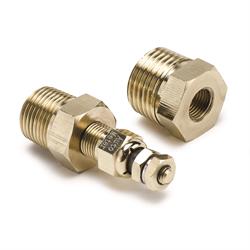Order a Free Catalog
Click Here to request one of Speedway's FREE catalogs!
Here to Help You
To reach our knowledgeable reps:
Call: 800.979.0122 800.979.0122
Order Line (CST)
7am - 10pm - Every Day!
Race and Rod Tech Support
M-Fri 8am - 5pm
Customer Service
M-Fri 8am - 5pm
International Customers Call
Speedway Motors is America’s Oldest Speed Shop® and has been a trusted source for high performance parts for street rods and racing for over 73 years. Speedway Motors has built a reputation for providing friendly expert advice and superior service. Whether you are racing, building a street rod or restoring an old classic, Speedway Motors has the performance parts you need – in stock and ready to ship today.

Installing a Tachometer or Water Temp Gauge
By Speedway Tech Team
Created 2014
Installing a tachometer or water temperature gauge has multiple benefits. First and foremost, not everyone has a finely calibrated ear for monitoring the RPM’s of your vehicle. And let’s face it, none of us is interested in having a finger on the engine to monitor temperature.
Thankfully, installing a tachometer or water temperature gauge is not very involved or complicated. You won’t even need very many specialized tools to get the job done, hand tools will suffice. The folks at Autometer put together a couple quick videos explaining what wire goes where, and why.
Installing a tachometer on a vehicle with a standard ignition system is a pretty easy process. On the harness there will be four wires, red, black, white, and green. The red wire is linked to a key-switched ignition source, to transfer power to the tachometer. Black, as is usually the case, is the ground. It is recommended that this be attached to a solid engine or chassis ground. Do this wrong, and you risk ruining the tachometer you were installing. The white wire is for the illumination of the tachometer, so that will be attached to the headlight switch of your vehicle. Make sure to tie it in to the power side when the switch is engaged, this will power the light on the tachometer at the same time as the rest of the lights on the dash. The green wire is your signal wire, which will be routed out to your ignition coil and attached to the negative side. You can also run the wire to the tachometer output terminal on an ignition control box if you have one.
Installing a water temperature gauge is just as simple as installing the tachometer was, regardless of whether you are installing a mechanical gauge or an electrical gauge. You’ll need to tap into a key-switched power source again, as the water temperature gauges are externally powered. Grounding is the same, follow the same guidelines listed above and have a good ground to either the engine or the frame. Lights on the gauge are the same, you will need to tap into the headlight switch output to ensure the lights on your water temperature gauge illuminate with the rest of the dash lights. Lastly, the sending unit, which could either be a standard short sweep electric gauge sender, or a full sweep electric gauge. The sending unit will be installed in an open water port on the intake manifold, cylinder head, or a water neck.
We hope you found these videos helpful, why not take a minute to browse the large selection of Autometer components available at Speedway Motors by clicking here.



